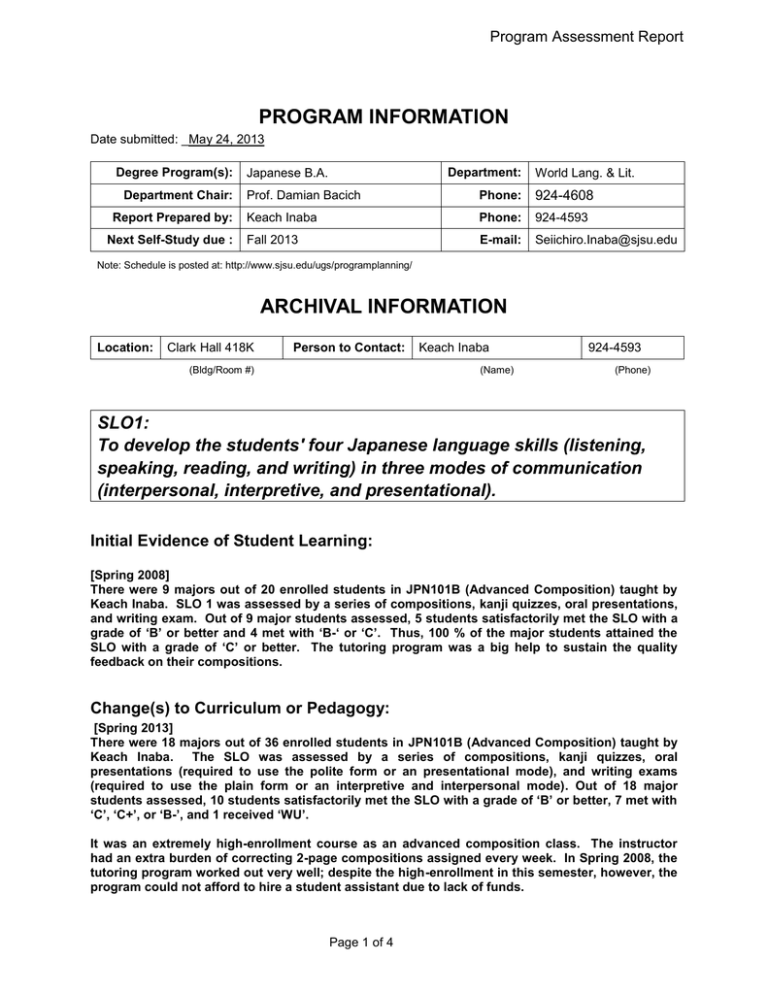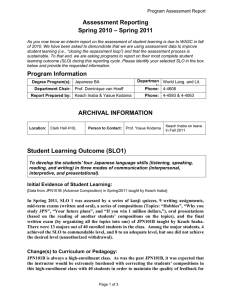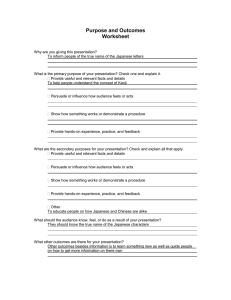PROGRAM INFORMATION Program Assessment Report
advertisement

Program Assessment Report PROGRAM INFORMATION Date submitted: _May 24, 2013 Degree Program(s): Department Chair: Report Prepared by: Next Self-Study due : Department: Japanese B.A. World Lang. & Lit. Prof. Damian Bacich Phone: 924-4608 Keach Inaba Phone: 924-4593 Fall 2013 E-mail: Seiichiro.Inaba@sjsu.edu Note: Schedule is posted at: http://www.sjsu.edu/ugs/programplanning/ ARCHIVAL INFORMATION Location: Clark Hall 418K Person to Contact: (Bldg/Room #) Keach Inaba (Name) 924-4593 (Phone) SLO1: To develop the students' four Japanese language skills (listening, speaking, reading, and writing) in three modes of communication (interpersonal, interpretive, and presentational). Initial Evidence of Student Learning: [Spring 2008] There were 9 majors out of 20 enrolled students in JPN101B (Advanced Composition) taught by Keach Inaba. SLO 1 was assessed by a series of compositions, kanji quizzes, oral presentations, and writing exam. Out of 9 major students assessed, 5 students satisfactorily met the SLO with a grade of ‘B’ or better and 4 met with ‘B-‘ or ‘C’. Thus, 100 % of the major students attained the SLO with a grade of ‘C’ or better. The tutoring program was a big help to sustain the quality feedback on their compositions. Change(s) to Curriculum or Pedagogy: [Spring 2013] There were 18 majors out of 36 enrolled students in JPN101B (Advanced Composition) taught by Keach Inaba. The SLO was assessed by a series of compositions, kanji quizzes, oral presentations (required to use the polite form or an presentational mode), and writing exams (required to use the plain form or an interpretive and interpersonal mode). Out of 18 major students assessed, 10 students satisfactorily met the SLO with a grade of ‘B’ or better, 7 met with ‘C’, ‘C+’, or ‘B-’, and 1 received ‘WU’. It was an extremely high-enrollment course as an advanced composition class. The instructor had an extra burden of correcting 2-page compositions assigned every week. In Spring 2008, the tutoring program worked out very well; despite the high-enrollment in this semester, however, the program could not afford to hire a student assistant due to lack of funds. Page 1 of 4 Program Assessment Report Evidence of Student Learning after Change. [Spring 2013] Judging from the results of the assessment, it is apparent that the success of the class was mainly attributed to the instructor’s hardworking attitude. Yet, it may well be very important to resume the tutoring program or to offer 2 sections of the course in the future. SLO2: To develop the students' understanding of some aspects of Japanese culture, including the relationships among cultural products, practices, and perspectives. Initial Evidence of Student Learning: [Fall 2008] In Fall 09, SLO 2 was assessed in JPN101A (Advanced Reading) taught by Keach Inaba. The class was a high-enrollment class with 40 students. Among them, there were 14 major students. Out of the 14 majors, 2 were fully achieve the SLO to a commendable level, 8 achieved to an adequate level, 3 did not achieved the desired level, and one received a grade of “I” due to her serious illness right before the final exam. As planned after Fall 08, a kanji exercise book was adopted. In comparison with that of Fall 08, however, the outcome shows no improvement of their reading and writing skills. To maintain the quality feedback on their kanji assignments, the instructor was extremely burdened with correcting them. The adoption of the kanji workbook itself did not bring a real success in supporting the students without quality feedback. It was assumed that the tutoring system was needed to maintain quality supports in this high-enrollment class. Change(s) to Curriculum or Pedagogy: [Fall 2012] A new textbook (“Tobira” Gateway to Advanced Japanese Learning Through Content and Multimedia) was adopted for JPN101A (Advanced Reading) and eight major lessons (geography, sports, food, religion, pop culture, traditional performing arts, education system, and convenience stores) were covered out of 14 lessons in the textbook. Also, the kanji exercise book accompanied with the textbook was used. There were 17 majors out of 34 enrolled students in the class taught by Keach Inaba. SLO 2 was assessed by a series of kanji quizzes, homework assignments, two oral & written exams, one oral presentation, and the final written exam. Out of 17 major students assessed, 13 students satisfactorily met the SLO with a grade of ‘B’ or better and 3 met with a grade of ‘C‘ or ‘C+’. Thus, 100 % of the major students attained the SLO with a grade of ‘C’ or better. Evidence of Student Learning after Change. [Spring 2013] The success of the class was greatly attributed to the adoption of the new textbook. The students seemed to enjoy the various topics covered in the class. In addition, there were manifold learning materials available on the web. The students had good opportunities to improve their four Page 2 of 4 Program Assessment Report language skills through the materials. On the other hand, there was a concern that the students were given too many assignments including kanji practices to fully digest all of the materials and the instructor had an extra burden of correcting them. Therefore, it is strongly recommended that two sections of JPN101A be offered in Fall or one section in every semester. PROGRAM INFORMATION Date submitted: May 24th 13 Degree Program(s): BA Japanese Department: Department Chair: Damian Birch Phone: World languages and literatures 408-924-4068 Report Prepared by: Yasue Kodama Yanai Phone: 408-924-4063 Next Self-Study due : 2013 Fall E-mail: Yasue.Yanai@sjsu.edu Note: Schedule is posted at: http://www.sjsu.edu/ugs/programplanning/ ARCHIVAL INFORMATION Location: Clark Hall 418K Person to Contact: (Bldg/Room #) Keach Inaba 4-4593 (Name) (Phone) SLO 4: To develop the students' understanding of not only traditional arts but also contemporary Japanese culture and society. Initial Evidence of Student Learning: [Data from JPN 102 in Spring 2011] This SLO was assessed by 23 quizzes, 1 mid-term, 1 final exam, 2 papers and 1 presentation on Japanese culture. The class took up various aspects of Japanese from traditional performing arts to pop-culture. Out of 23 students enrolled, 22 have completed all of the course requirements: 16 Commendable, 6 adequate and 0 unsatisfactory. Change(s) to Curriculum or Pedagogy: [JPN 102 in Fall 2012] Based on the students’ comments and results of tests, quizzes, paper and homework, I completely renovated this class from knowledge-based course to experiential learner-centered course. I changed this course into a collaborative international online course with Kagoshima University in Japan using web communication tools such as Google hangout and Webex and let my students learn Japanese culture and their own culture by interviewing each other in Japanese language on various topics. Evidence of Student Learning after Change. [JPN102 in Fall 2012] The students were more motivated in the class and they did not have any time to fall asleep during the class because they were the main characters and they decided on what they interviewed with the students in Kagoshima, Japan. Some students showed some worries to this new pedagogy using new online technology at the beginning, but this was successful trail course for the first time. I received many encouragements from my students to continue this type of Page 3 of 4 Program Assessment Report experiential culture course. The presentations students gave in each group at the end of the course were wonderful and they gained certain confidence on their intercultural communication in Japanese language. Out of 30 students enrolled, 29 have completed all of the course requirements: 21 Commendable, 8 adequate and 0 unsatisfactory. SLO 6: To develop experience and skills in reading and discussing Japanese modern literature from 1868 through the present. Initial Evidence of Student Learning: [Data from JPN160 in Fall 2011] This SLO was assessed by 2 storytellings (oral experiential narratives), 3 writing assignments (a folk tale translation, a folk tale comparative analysis and a life story), 1 oral presentation (folk tale comparative analysis), 19 peer evaluations on oral experiential narratives. We took up Japanese folk tales and oral experiential narratives in the first half semester, and life stories in the latter half. Out of 19 students enrolled, 17 have completed all of the course requirements: 14 Commendable, 3 adequate and 0 unsatisfactory. Change(s) to Curriculum or Pedagogy: [JPN160 in Spring 2013] Based on the students’ comments, I added more Japanese folk tales, so that they can learn more onomatopoeia and a variety of Japanese folk stories. Also, I included the reading assignments into the grade to focus on the reading skills and cultural discussion on Japanese folk tales. On the other hand, I changed the language of the oral presentation on comparative analysis of the folk tales from Japanese language to English, putting an emphasis on the content of the analysis because the students were not at the level of making the presentation in Japanese language. Evidence of Student Learning after Change. [JPN160 in Spring 2013] By changing the students’ presentation language from Japanese to English and increasing the reading assignments of Japanese folk tales, students were able to have the deeper understanding of the differences between Japanese folk tales and their culture’s folk tales. Out of 17 students, 15 students completed all of the course requirements, and 14 students were commendable, 1 adequate and 0 unsatisfactory. Page 4 of 4

